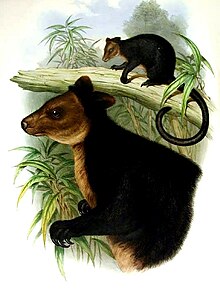| Ursine tree-kangaroo | |
|---|---|

| |
| Conservation status | |
 Vulnerable (IUCN 3.1) | |
| CITES Appendix II (CITES) | |
| Scientific classification | |
| Domain: | Eukaryota |
| Kingdom: | Animalia |
| Phylum: | Chordata |
| Class: | Mammalia |
| Infraclass: | Marsupialia |
| Order: | Diprotodontia |
| Family: | Macropodidae |
| Genus: | Dendrolagus |
| Species: | D. ursinus |
| Binomial name | |
| Dendrolagus ursinus (Temminck, 1836) | |

| |
| Ursine tree-kangaroo range | |
The ursine tree-kangaroo (Dendrolagus ursinus) is a long-tailed, furry, bear-like mammal found only in tropical forests on the island of New Guinea (in Indonesia). Slightly larger than a cat, it lives alone in trees and is active at night to feed on leaves and fruit. It belongs to the macropod family (Macropodidae) with kangaroos, and carries its young in a pouch like other marsupials. It has a small range in northwestern New Guinea and is threatened by habitat loss and hunting. Other common names for this species include the black tree-kangaroo, the Vogelkop tree-kangaroo and the white-throated tree-kangaroo.
Description
This tree-kangaroo grows to a head-and-body length of 50 to 82 cm (20 to 32 in) with a tail of 40 to 94 cm (16 to 37 in), and a weight of up to 8 kg (18 lb). The upper parts are glossy black while the underparts are fawn. There is a whitish collar and throat, and the face is brown with white or red cheeks. The ears are distinctive, being long and tufted. The long fur is whorled on the shoulders, a pattern which is thought to help carry excess rainwater away from the head. Compared to terrestrial kangaroos, the limbs are short, with broad feet, well-roughened soles and curled claws for climbing. The tail is long and tipped with white and is used as a counterbalance.
Distribution and habitat
Endemic to the island of New Guinea, the species is present on the Vogelkop Peninsula in the far northwest of the island and possibly also the Fakfak Peninsula in West Papua. It occurs in tropical forests at altitudes between 1,000 and 2,500 m (3,300 and 8,200 ft).
Biology
The ursine tree-kangaroo is nocturnal, solitary and lives mainly in trees, though it can descend to the ground where its gait is bipedal, hopping rather clumsily on its hind legs. It is much more agile among the branches of trees, where it feeds on fruit and leaves. Breeding is thought to take place at any time of year. Being a marsupial, a tiny neonate is born about thirty days after conception, and wriggles through the fur of the mother's abdomen to the pouch. Here it attaches to a nipple and develops for about three hundred days.
Status
D. ursinus has a very limited range and is declining in numbers; the population is thought to have diminished by at least 30% within the last three generations (thirty years). The two main threats it faces are habitat destruction as forests are cleared to provide farming land, and hunting by indigenous peoples for food. Historically, it used to be present in lowland forests, but now it only occurs in mountain forests. The International Union for Conservation of Nature has assessed its conservation status as being "vulnerable".
References
- Groves, C. P. (2005). "Order Diprotodontia". In Wilson, D. E.; Reeder, D. M (eds.). Mammal Species of the World: A Taxonomic and Geographic Reference (3rd ed.). Johns Hopkins University Press. p. 61. ISBN 978-0-8018-8221-0. OCLC 62265494.
- ^ Leary, T.; Seri, L.; Wright, D.; Hamilton, S.; Helgen, K.; Singadan, R.; Menzies, J.; Allison, A.; James, R.; Dickman, C.; Aplin, K.; Salas, L.; Flannery, T.; Bonaccorso, F. (2016). "Dendrolagus ursinus". IUCN Red List of Threatened Species. 2016: e.T6434A21956516. doi:10.2305/IUCN.UK.2016-2.RLTS.T6434A21956516.en. Retrieved 14 November 2021.
- "Appendices | CITES". cites.org. Retrieved 2022-01-14.
- ^ "Black tree kangaroo (Dendrolagus ursinus)". ARKive. Archived from the original on 2018-04-03. Retrieved 2 April 2018.
| Taxon identifiers | |
|---|---|
| Dendrolagus ursinus |
|